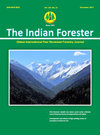Wood Anatomy of Indian Shrubs of Euphorbiaceae S.L.: Identification, Ecological and Evolutionary Perspectives
DOI:
https://doi.org/10.36808/if/2017/v143i12/120388Keywords:
Euphorbiaceae, Identification, Indian, Shrubs, Wood Anatomy.Abstract
The present study deals with detailed wood microstructure of shrubs of the family Euphorbiaceae from India. Ten species belonging to 6 genera of Euphorbiaceae have been described on the basis of their detailed wood microstructure, salient diagnostic features and photomicrographs. An identification key based on wood anatomical features has been developed for the separation of the species. These species have quite different wood structure and are easily separable. However, these differences suggest unnatural classification of the family. The present study is useful in species identification and also reflecting ecological and evolutionary aspects.References
Alves E.S. and Angyalossy-Alfonso V. (2002). Ecological trends in the wood anatomy of some Brazilian species. 2. Axial parenchyma, rays and fibres. IAWA Journal, 23: 391–418.
Baas P., Werker E. and Fahn A. (1983). Some ecological trends in vessel characters. IAWA Bull, n.s. 4: 141–159.
Balakrishnan N.P., Chakrabarty T. (2007). The family Euphorbiaceae in India, a synopsis of its profile, taxonomy and bibliography. 500p; Bishen Singh and Mahendra Pal Singh, Dehradun, India.
Bailey I.W. (1957). The potentialities and limitations of wood anatomy in the study of phylogeny and classification of Angiosperms. J. Arn. Arbor., 38: 243–254.
Barajas-Morales J. (1985). Wood structural differences between trees of two tropical forests in Mexico. IAWA Bull, n.s. 6: 355–364.
Carlquist S. (1966). Wood anatomy of Compositeae: a summary, with comments on factors controlling wood evolution. Aliso, 6(2): 25-44.
Carlquist S. (1977). Ecological factors in wood evolution: a floristic approach. Am. J. Bot., 64: 887–896.
Carlquist S. (1988). Comparative wood anatomy: systematic and evolutionary aspects of dicotyledons woods. Springer Verlag, Berlin, Germany.
Carlquist S. and Hoekman D.A. (1985). Ecological wood anatomy of the woody southern Californian flora. IAWA Bull, n.s. 6: 319–347.
Carlquist S. (2001). Comparative wood anatomy: systematic and evolutionary aspects of dicotyledons woods. 2nd ed., New York: SpringerVerlag, Berlin, Germany.
Falster D.S. and Westoby M. (2003). Plant height and evolutionary games. Trends in Ecology & Evolution, 18: 337–343.
Gamble J.S. (1922). A manual of Indian timbers. 2nd ed., Sampson Low and Marston Co. Ltd, London.
Govaerts R., Frodin D.G., and Radcliffe-Smith A. (2000). World checklist and bibliography of Euphorbiaceae. 4 vols. Kew: Royal Botanic Gardens.
IAWA Committee. (1989). IAWA list of microscopic features for hardwood identification. IAWA Bulletin, n.s. 10: 219–332.
King D. A. (1990). The adaptive significance of tree height. American Naturalist, 135: 809 – 828.
Kribs D.A. (1935). Salient lines of structural specialization in the wood rays of dicotyledons. Bot. Gaz., 96: 547-557.
Luchi A.E., Silva L.C.P., and Moraes M.A. (2005). Anatomia comparada do lenho de Xylopia aromatica (Lam.) Mart. em áreas de cerrado e de plantação de Pinus elliottii Engelm. Braz. J. Bot., 28: 809–820.
Mennega A.M.W. (1987). Wood anatomy of Euphorbiaceae in particular of subfamily Phyllanthoideae, Botanical J. Linnaean Society, 11-126.
MartÃnez-Cabrera H.I., Schenk H.J., Sergio R.S. Cevallos F. and Cynthia S.J. (2011). Integration of vessel traits, wood density, and height in angiosperm shrubs and trees. American J. Botany, 98(5): 915–922.
Metcalfe C.R. and Chalk L. (1950). Anatomy of the dicotyledons. Vol. 2, Oxford at the Clarendon press.
Jangid P.P. and Gupta S. (2015). Wood anatomy of Croton L. (Euphorbiaceae) reflecting systematic, ecological and evolutionary aspects. Indian Forester, 141 (2): 154-160.
Jangid P.P. and Gupta S. (In press). Comparative wood anatomy of Indian Drypetes and Putranjiva (Putranjivaceae): systematic implications, identification and comments on the synonymy of D. sumatrana. Nordic Journal of Botany, Doi 10.1111/njb.00850.
Petit R.J. and Hampe A. (2006). Some evolutionary consequences of being a tree. Annual Review of Ecology, Evolution and Systematics, 37: 187 – 214.
Radcliffe-Smith A. (1987). Segregate families from the Euphorbiaceae. Botanical J. Linnean Society, 94(1-2): 47–66.
Raturi R.D., Chauhan L. and Gupta S. (2001). Indian Woods: their identification properties and uses. Vol. 6, Pub. I.C.F.R.E. Dehradun, India.
Rury P.M. (1985). Systematic and ecological wood anatomy of Erythroxylaceae. IAWA Bull. n.s. 6: 365-397.
Ryan G.M. and Yoder B.J. (1997). Hydraulic limits to tree height and tree growth. BioScience, 47: 235–242.
Webster G.L. (1994). Synopsis of the genera and suprageneric taxa of Euphorbiaceae. Annals of the Missouri Botanical Garden, 81: 33–144.
Weidenhoeft A.C., Benjamin V.E., and Berry P.E. (2008). Tracking the phylogeny of Crotoneae with comparative wood anatomy of Croton. University of Wisconsin, Madison.
Yatsenko-Khmelevskyi A.A. (1954). Osnovy i metody anatomicheskogo issledovaniya drevesiny (Principals and method of anatomical investigation of wood), 337p. Izdatel'stvo akademii Nauk SSSR, Moscow-Leningrad.
Zimmermann M.H. (1983). Xylem structure and the ascent of sap. 283 p. Springer-Verlag, Berlin.
Downloads
Downloads
Published
How to Cite
Issue
Section
License
Unless otherwise stated, copyright or similar rights in all materials presented on the site, including graphical images, are owned by Indian Forester.





